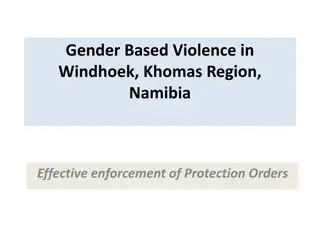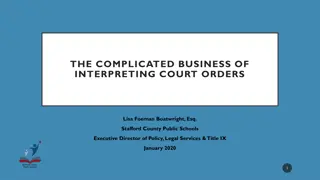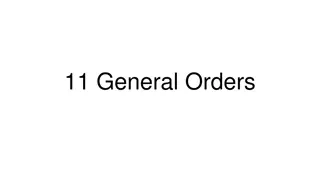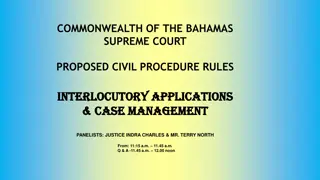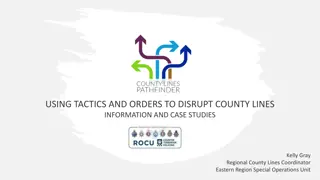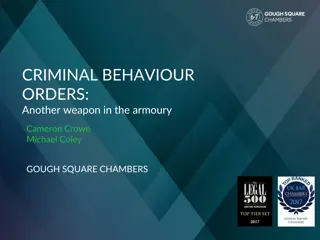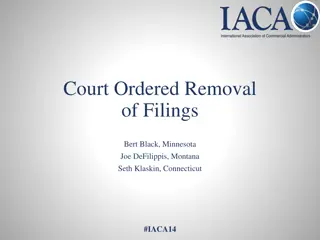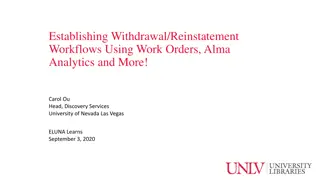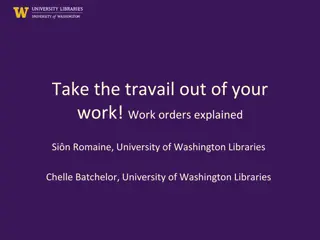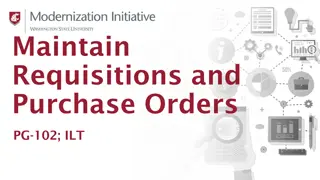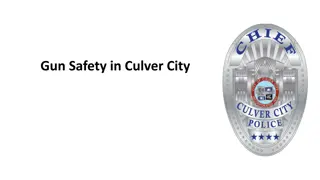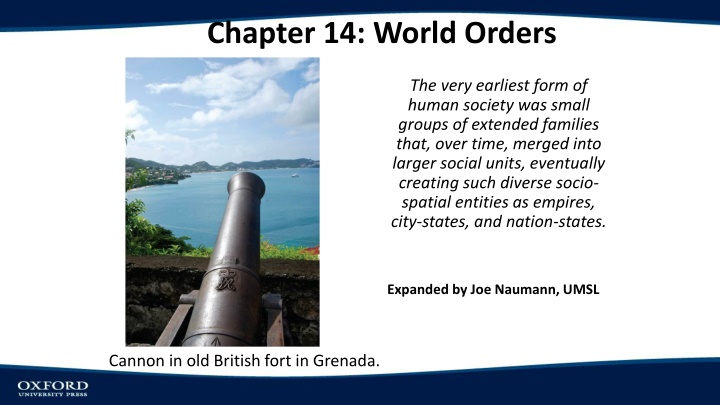
Chapter 14: World Orders
Early human societies evolved from small groups of extended families into diverse socio-spatial entities such as empires, city-states, and nation-states. This development shaped global integration, imperial overstretch, and imperial disintegration over time, impacting the world's political geography.
Download Presentation

Please find below an Image/Link to download the presentation.
The content on the website is provided AS IS for your information and personal use only. It may not be sold, licensed, or shared on other websites without obtaining consent from the author. If you encounter any issues during the download, it is possible that the publisher has removed the file from their server.
You are allowed to download the files provided on this website for personal or commercial use, subject to the condition that they are used lawfully. All files are the property of their respective owners.
The content on the website is provided AS IS for your information and personal use only. It may not be sold, licensed, or shared on other websites without obtaining consent from the author.
E N D
Presentation Transcript
Chapter 14: World Orders The very earliest form of human society was small groups of extended families that, over time, merged into larger social units, eventually creating such diverse socio- spatial entities as empires, city-states, and nation-states. Expanded by Joe Naumann, UMSL Cannon in old British fort in Grenada.
Chapter Learning Objectives Summarize the iterations of human societies from their initial small-group forms and into more diverse, complex political forms. Discuss the rise and fall of global empires and their impact on the current political geography of the world. Explain how empires promoted global integration as they spread spatially and incorporated a variety of peoples. Outline examples of the limits to empire, imperial overstretch, and imperial disintegration. Describe the trends associated with the emergence of a new world geopolitical order.
Early Cradles of Civilization
Early Empires Human society Early forms of extended families Over time, larger social units with more socio- spatial structures Themes from early Mesopotamia Uruk expansion and decline Repeating process for empires The Persian Empire covered a vast area, its spatial expansion aided by greater use of cavalry and better roads.
Early Empires Rise and fall of imperialism With globalization, territorial extent grows and impact of imperial incorporation endures Empires grow with better transportation and technology Then distance decay impacts military and political reach Empires promoted global integration More recent empires, greater enduring influences Spatial elements: global integration, imperial overstretch, and imperial disintegration
Global Integration Early modernity and empires of 1400 to 1800 Empires facilitated movement of peoples, cultures, knowledge, and practices Push to empire largely driven by economics and access to resources Core-periphery spatial structure to global political economy is a legacy of this period Colonization involved rewriting space to show who was in control and who was controlled Cities and settlements segmented by race Central spaces of observation and in/out distinctions displayed and maintained colonial power
The Caribbean as Imperial Shatter Zone Changing ownership of island groups Difficult to control Sugar colonies Slave trade Need for labor Transformed culture, economics, and politics in the region Imperialism in the region Islands had shifting, multiple allegiances Imperial control still evident in region Willemstad, Cura ao, retains its Dutch architectural heritage. From 1634, under Dutch control, it was center of the slave trade.
Global Integration Local elites reproduce the imperial center Can encourage and secure colonial rule Must maintain legitimacy, or colonial powers intervene Core-Periphery spatial structure Periphery as source of raw materials and market for goods produced in the core Basis for subsequent economic development of the core that industrialized at the expense of periphery Unequal exchange remains between core and periphery; liable for developing world poverty
Global Integration Age of Imperialism from 1880 to 1918 Scramble to incorporate more of the periphery Growing competition between core powers Territorial expansion of US and Russian/Soviet Empire The Cold War between US and USSR 1947 to 1964: Postwar phase as USSR claimed most of Eastern Europe by establishing communist regimes 1964 to 1979: Phase of d tente ends with USSR invasion of Afghanistan 1980 to 1991: Military buildup and escalation USSR collapse left US as only global superpower
Global Integration The US Empire Not traditional colonial empire Worldwide military-industrial-security complex of military bases Visions of global hegemony and order Less about territory and more maintaining economic connectivity Economic neocolonialism in the Caribbean and Central America Teaching the US Empire, 1900.
Global Integration LEFT: Africa 1880 RIGHT: Africa 1914
Imperial Overstretch Tendency for empires to expand beyond their ability to maintain economic and military power Limits to empire Information overload Fiscal limit and ability to pay for all commitments Strategic limits, as nature of conflicts change and large powers are slow to change Legitimation crisis emerges when public support is lost, especially for military involvements
Imperial Disintegration Decolonization Imperial powers left or lost to independence movements First wave: 1945 to 1954 in Asia Second wave in Africa Colonial borders remained and conflicts reawakened with independence Irrational boundaries Lacked knowledge of the physiography and the cultural boundaries of tribes, kingdoms, and empires
Imperial Disintegration Political map of contemporary Africa. Compare with Figure 14.3 (slide 10, left) to see the enduring legacy of colonial borders.
Imperial Disintegration Collapse of the Soviet Union in 1991 Stopped cracking down on uprisings Fall of the symbolic Berlin Wall Former republics left the Union Variety of new independent countries emerged The Soviet breakup
The Clash of Civilizations? Huntington s Clash of Civilizations Peoples divided along cultural lines of religion, history, and geography Nine different types Criticisms Real world is more fractured, spatial units more heterogeneous Arab Spring, the democratic uprisings of 2011, disproved his Islamic world premise Huntington s clash of civilizations.
Elements of a New World Order Four trends 1. US as world s only global superpower o Military and economic hegemony, costs of power 2. Rise of security groupings and mutual defense organizations o Diplomacy, security, and peacekeeping forces of the United Nations, NATO, etc. 3. Reemergence of alternative power sources to the US o Alternative economic centers that share US goals, like the EU, to economic and military rivals like China and Russia 4. Rise of non-state actors o Includes social movements, like Arab Spring, as well as transnational terrorist groups, like Al Qaeda and ISIS
Elements of a New World Order RISE OF CHINA Second largest world economy Trade liberalization success Demand for resources has meant significant investment in South America and Africa Founded the Asian Infrastructure Investment Bank (AIIB) as alternative to IMF Military buildup, mostly on regional scale building islands in the South China Sea High growth difficult to maintain long-term Wages are rising in China Potential political unrest Other countries reacting and responding to China s rise
Elements of a New World Order NON-STATE ACTORS Al Qaeda Global terrorist organization with regional offshoots Promote Islamic fundamentalism against non-Muslims, non-Sunni ISIS, ISIL, or Daesh Sunni movement out of post-invasion Iraq Territorial conquest in region s failed states Affinities from alienated Muslim youth in the West (a) Countries with ISIS provinces; (b) ISIS militants parade through Northern Syria in 2014.
Pentagons View of the World End of Cold War and disintegration of Soviet Bloc made US world s sole superpower Pentagon s worldview Functioning core of relative stability Non-integrating gap of instability; places of US involvement The Pentagon s world map.
Also as part of NATO force: Kosovo Estonia Poland Latvia Lithuania
Chapter Summary Although the earliest forms of human activity were but small groups of extended families, they eventually merged into larger social units and even highly diverse and widespread empires. Across time and over space, the same process repeats itself: empires emerge, extend their reach, and then collapse from external pressures and internal conflicts. Better transport and improved road networks enable empires to extend their spatial reach. Yet empires, no matter how vast, have territorial limits to their power. Recent empires have greater global influence. The recent history of empires has three distinct spatial elements: global integration, imperial overreach, and imperial disintegration.
Chapter Summary Some researchers have identified three broad strategies for the framing of colonial states: producing a plan of urban segmentation that includes racial segregation, creating a fixed distinction between inside and outside, and constructing central spaces of observation to keep an eye on things and to show the presence of colonial power. Whether in intellectual discourses and practices, such as cartography and mapmaking, or in sports, language, religion, and forms of government, modern empires have integrated much of the world. The push to empire in the modern world was largely driven by economics.
Chapter Summary There is a tendency for empires to expand beyond their ability to maintain economic dominance and military power, deemed imperial overreach. Among the numerous limits to maintaining and expanding an empire are information overload, fiscal limitations, and strategic limits. Although empires may develop into vast economic and geographic worldwide forces, throughout history empires have eventually disintegrated. However, rarely has the process come easily and without dramatic impact on the people and locations left in their wake. In the emerging world order, important trends include the continuing hegemony of the USA, the growth of international military authorities, the reemergence of Russia, the rise of China, and the danger of non-state terrorist actors.

